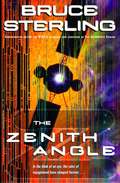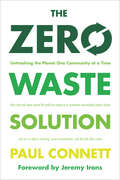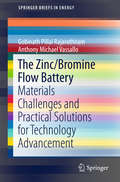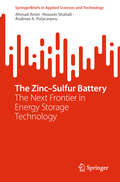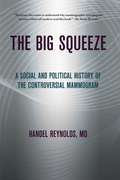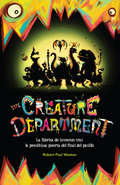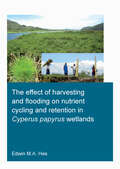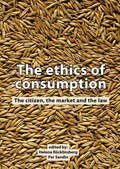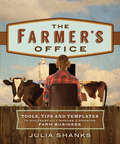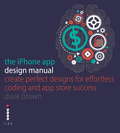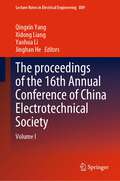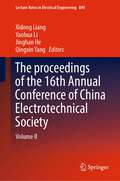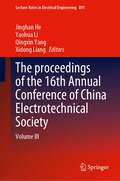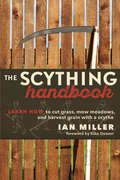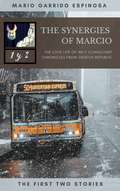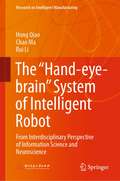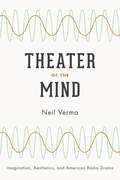- Table View
- List View
The Zenith Angle: A Novel
by Bruce Sterling&“Gleeful, shrewd, speculative, cynical, closely observed . . . The Zenith Angle offers wisdom and solace, thrills and laughter.&”—The Washington Post&“Compelling and important . . . A darkly comic fable of info-war, the black budget, über-geek idealism, and the politics of Homeland Insecurity.&”—William Gibson, author of Pattern Recognition Pioneering computer wizard Derek &“Van&” Vandeveer has been living extra-large as a VP for a booming Internet company. But the September 11 attacks on America change everything. Recruited as the key member of an elite federal computer-security team, Van enters the labyrinthine trenches of the Washington intelligence community. His special genius is needed to debug the software glitch in America&’s most crucial KH-13 satellite, capable of detecting terrorist hotbeds worldwide. But the problem is much deeper. Now Van must make the unlikely leap from scientist to spy, team up with a ruthlessly resourceful ex-Special Forces commando, and root out an unknown enemy—one with access to a weapon of untold destructive power.&“Great fun . . . A cyberthriller of 21st-century technologies [that] peeps wittily behind the national security scenes of a modern superpower.&”—New Scientist&“A comedic thriller for the homeland security era.&”—Entertainment Weekly
The Zero Waste Solution: Untrashing the Planet One Community at a Time
by Paul ConnettWaste is something we all make every day but often pay little attention to. That's changing, and model programs around the globe show the many different ways a community can strive for, and achieve, zero-waste status.Scientist-turned-activist Paul Connett, a leading international figure in decades-long battles to fight pollution, has championed efforts to curtail overconsumption and keep industrial toxins out of our air and drinking water and bodies. But he&’s best known around the world for leading efforts to help communities deal with their waste in sustainable ways—in other words, to eliminate and reuse waste rather than burn it or stow it away in landfills.In The Zero Waste Solution, Connett profiles the most successful zero-waste initiatives around the world, showing activists, planners, and entrepreneurs how to re-envision their community&’s waste-handling process—by consuming less, turning organic waste into compost, recycling, reusing other waste, demanding nonwasteful product design, and creating jobs and bringing community members together in the process. The book also exposes the greenwashing behind renewed efforts to promote waste incinerators as safe, nontoxic energy suppliers, and gives detailed information on how communities can battle incineration projects that, even at their best, emit dangerous particles into the atmosphere, many of which remain unregulated or poorly regulated.An important toolkit for anyone interested in creating sustainable communities, generating secure local jobs, and keeping toxic alternatives at bay.
The Zero-G Headache (AstroKids #2)
by Robert ElmerMeet the AstroKids--DeeBee, Buzz, Miko, Mir, and Tag--five friends learning biblical truth through out-of-this-world adventures aboard space station CLEO-7. "'DeeBee's a GEEN-ius.' Suffering satellites, that's all I ever hear! So I understand basic quantum theory. I mean, who doesn't, right? "Anyway, can you believe it? Zero-G, The most popular band in the galaxy, was coming to perform at CLEO-7. Now. . . I think Zero-G's music is pretty lame -- but don't tell that to the other AstroKids! I was more interested in finding out why my geeky cousin Phil was on Zero-G's shuttle. . . and what exactly he was hiding in that mysterious blue plasma barrel".
The Zinc/Bromine Flow Battery
by Gobinath Pillai Rajarathnam Anthony Michael VassalloThis book presents a detailed technical overview of short- and long-term materials and design challenges to zinc/bromine flow battery advancement, the need for energy storage in the electrical grid and how these may be met with the Zn/Br system. Practical interdisciplinary pathways forward are identified via cross-comparison and comprehensive review of significant findings from more than 300 published works, with clear in-depth explanations spanning initial RFB development to state-of-the-art research in related systems. Promising strategies described include the use of modern electrochemical techniques to study and optimize physical processes occurring within the system during operation, improving zinc electroplating quality during the charge phase through the strategic use of organic additives, as well as identifying suitable catalysts to optimize the bromine/bromide redox couple. The primary focus is on research and development of novel materials in the areas of electrolyte formulation and multifunctional "smart" electrode surfaces to achieve a higher degree of control over processes at the electrode-electrolyte interface. The strategies suggested in this book are also highly adaptable for use in other similar flow battery systems, while the unique cross-comparative approach makes it a useful reference and source of new ideas for both new and established researchers in the field of energy storage and battery technology.
The Zinc–Sulfur Battery: The Next Frontier in Energy Storage Technology (SpringerBriefs in Applied Sciences and Technology)
by Ahmad Amiri Hossein Shahali Andreas A. PolycarpouThe book starts with a foundational overview, providing readers with insights into the evolution of battery technology and the historical backdrop that has shaped the landscape of zinc-sulfur batteries before looking into their chemistry and construction. Readers are guided through the fundamentals of battery chemistry, exploring electrochemical principles, key components, and the basic reactions that underpin zinc-sulfur batteries. The book explains design considerations, from cell components and materials to electrode configurations as well as charge and discharge processes, cycling behavior, and considerations of capacity and efficiency. It summarizes recent advances and research trends. Applications of zinc-sulfur batteries are reviewed: from electronics to electric vehicles, renewable energy storage, and military and aerospace applications including real-world case studies. Supplemented by appendices containing a glossary of terms, references, abbreviations, and an index, This book is a definitive resource for researchers, practitioners, and enthusiasts seeking to unravel the complexities and capitalize on the potential of this transformative energy storage technology.
The big squeeze: a social and political history of the controversial mammogram
by Handel ReynoldsIn 2009, an influential panel of medical experts ignited a controversy when they recommended that most women should not begin routine mammograms to screen for breast cancer until the age of fifty, reversing guidelines they had issued just seven years before when they recommended forty as the optimal age to start getting mammograms. While some praised the new recommendation as sensible given the smaller benefit women under fifty derive from mammography, many women's groups, health care advocates, and individual women saw the guidelines as privileging financial considerations over women's health and a setback to decades-long efforts to reduce the mortality rate of breast cancer.In The Big Squeeze, Dr. Handel Reynolds, a practicing radiologist, notes that this episode was only the most recent controversy in the turbulent history of mammography since its introduction in the early 1970s. In a book written for the millions of women who face the decision about whether to get a mammogram, health professionals interested in cancer screening, and public health policymakers, Reynolds shows how pivotal decisions made during mammography's initial launch made it all but inevitable that the test would be contentious. He describes how, at several key points in its history, the emphasis on mammography screening as a fundamental aspect of women's preventive health care coincided with social and political developments, from the women's movement in the early 1970s to breast cancer activism in the 1980s and '90s.At the same time, aggressive promotion of mammography made the screening tool the cornerstone of a huge new industry. Taking a balanced approach to this much-disputed issue, Reynolds addresses both the benefits and risks of mammography, charting debates, for example, that have weighed the early detection of aggressively malignant tumors against unnecessary treatments resulting from the identification of slow-growing and non-life-threatening cancers. The Big Squeeze, ultimately, helps to evaluate the ongoing public health controversies surrounding mammography and provides a clear understanding of how mammography achieved its current primacy in cancer screening.
The business of space
by Louis Brennan Alessandra VecchiThis book looks at the space industry from a business perspective, with a focus on international competition. The space industry traces its origins to the middle of last century as a government/military domain and the author now looks at the ongoing evolution of space exploration and travel, and projects the future of the industry.
The creature department.: La fábrica de inventos tras la penúltima puerta del final del pasillo (The\creature Department Ser. #1)
by Robert Paul WestonUn laboratorio escondido.Un increíble invento.Y unas criaturas bastante inusuales...Elliot y Leslie creían que en Bickleburgh nunca pasaba nada. Bueno, excepto dentro de la Denki-3000: la quinta compañía tecnológica más grande del mundo.Tras sus torres de cristal y pasadizos elevados hay una vieja mansión de la que surgen los inventos más increíbles que puedas imaginar. Y sólo el tío Archie sabe lo que en realidad esconde la penúltima puerta al final del pasillo.Claro, hasta que Elliot y Leslie echan un vistazo adentro... Tentáculos, criaturas con aspecto de trol y dientes rotos. Seres con alas enanas que chisporrotean al volar... ¡Pero atentos! El secreto mejor guardado de la Denki-3000 corre peligro, y Elliot, Leslie y las extrañas criaturas no tienen un segundo que perder. Tic, tac, tic, tac...Una aventura llena de humor con personajes divertidos y cercanos.Con excéntricas ilustraciones.La crítica ha dicho...«Impresionante... Es como si tomaras un poco de la película de Charlie y la fábrica de chocolate y Monsters Inc., y lo metieras en una nave como la tardis.» Buzz Feed«Weston destaca en cuanto al desarrollo de personajes de monstruos, y su imaginación va a toda velocidad, muy disfrutable.» Quill and Quire«Aunque esta deliciosa novela se concibió para niños de entre 8 y 12 años, cualquier persona con sensibilidad la disfrutará.» Library Journal«De un ritmo ágil, el estilo de Weston está repleto de agudo humor y conversaciones inteligentes.» University of Manitoba Library Association
The effect of harvesting and flooding on nutrient cycling and retention in Cyperus papyrus wetlands (IHE Delft PhD Thesis Series)
by Edwin M.A. HesAfrican papyrus (Cyperus papyrus L.) wetlands provide water, food and materials to millions of people, and perform important landscape functions such as water and nutrient storage, habitat provision for fish, birds and other wildlife. They are also an integral part of the culture of African wetland communities. With an increasing demand for food, papyrus wetlands are at risk of conversion to agriculture and losing these ecosystem services. Combining increased agricultural production with wetland conservation is urgently needed. The research presented in this book consisted of two parts. First, field experiments investigated nitrogen and phosphorus retention, showing that papyrus grows faster with disturbance from human activities or flooding, but produces less biomass and stores less nutrients. Then, a dynamic simulation model (Papyrus Simulator) based on the hydrological and ecological wetland processes showed that assimilation, mortality, decay, re-translocation, nutrient inflow and soil porosity were the most influential factors. The model demonstrated that controlled harvesting can increase nutrient retention by up to 40%, but overharvesting leads to the release of nutrients. These findings can help determining optimum harvesting strategies for constructed and natural wetlands, and contribute to the quantification of ecosystem services and an evidence-based adaptive management approach for African wetland landscapes.
The ethics of consumption
by Per Sandin Helena RöcklinsbergWe are all consumers. What we consume, how, and how much, has consequences of great moral importance for humans, animals, and the environment. Great challenges lie ahead as we are facing population growth and climate change and reduced availability of fossil fuels. It is often argued that key to meeting those challenges is changing consumption patterns among individual as well as institutions, for instance through reducing meat consumption, switching to organic or fair trade products, boycotting or 'buycotting' certain products, or consuming less overall. There is considerable disagreement regarding how to bring this about, whose responsibility it is, and even whether it is desirable. Is it a question of political initiatives, producer responsibility, the virtues and vices of individual consumers in the developed world, or something else? Many of these issues pose profound intellectual challenges at the intersection of ethics, political philosophy, economics, and several other fields. This publication brings together contributions from scholars in numerous disciplines, including philosophy, law, economics, sociology and animal welfare, who explore the theme of 'the ethics of consumption' from different angles.
The farmer's office: tools, tips and templates to successfully manage a growing farm business
by Julia ShanksYou decided to become a farmer because you love being outside, working the land and making a difference in the way we eat and farm. And when you decided to become a farmer, you also became an entrepreneur and business person. In order to be ecologically and financially sustainable, you must understand the basics of accounting and bookkeeping, and learn how to manage a growing business. Author Julia Shanks distills years of teaching and business consulting with farmers into this comprehensive, accessible guide. She covers all aspects of launching, running and growing a successful farm business through effective bookkeeping and business management, providing tools to make managerial decisions, apply for a loan or other financing, and offering general business and strategy advice for growing a business. Whether you've been farming for many years or just getting started, The Farmer's Office gives you the tools needed to think like an entrepreneur and thoughtfully manage your business for success. Julia Shanks works with food and agricultural entrepreneurs to achieve financial and operational sustainability. She has worked with a range of beginning and established farmers, providing technical assistance and business coaching that has allowed them to launch, stabilize and grow their ventures. A frequent lecturer on sustainable food systems and accounting, she sits on the advisory board of Future Chefs and is the regional leader of Slow Money Boston. Together with Brett Grohsgal, she is also co-author of The Farmers Market Cookbook.
The gm/ID Methodology, a sizing tool for low-voltage analog CMOS Circuits
by Paul JespersIC designers appraise currently MOS transistor geometries and currents to compromise objectives like gain-bandwidth, slew-rate, dynamic range, noise, non-linear distortion, etc. Making optimal choices is a difficult task. How to minimize for instance the power consumption of an operational amplifier without too much penalty regarding area while keeping the gain-bandwidth unaffected in the same time? Moderate inversion yields high gains, but the concomitant area increase adds parasitics that restrict bandwidth. Which methodology to use in order to come across the best compromise(s)? Is synthesis a mixture of design experience combined with cut and tries or is it a constrained multivariate optimization problem, or a mixture? Optimization algorithms are attractive from a system perspective of course, but what about low-voltage low-power circuits, requiring a more physical approach? The connections amid transistor physics and circuits are intricate and their interactions not always easy to describe in terms of existing software packages. The gm/ID synthesis methodology is adapted to CMOS analog circuits for the transconductance over drain current ratio combines most of the ingredients needed in order to determine transistors sizes and DC currents.
The iPhone App Design Manual: Create Perfect Designs for Effortless Coding and App Store Success
by Dave Brown Vicky RobertsThe creation of apps for Apple's iPhone is now a huge, and global business, with hundreds of thousands of developers, entrepreneurs and companies attracted by the potential rewards. But games, functional apps and promotional apps alike depend on attractive, intuitive design for their appeal, and most fail to find a significant audience.With this book, you'll be able to turn your great app idea into a functioning design that is ready for coding, or apply graphic design skills to this exciting and lucrative marketplace. You will have a clearly visualised concept and a focused sales plan - and your app will stand out in an App Store that is worth well over a billion pounds every year.
The proceedings of the 10th Frontier Academic Forum of Electrical Engineering: Volume I (Lecture Notes in Electrical Engineering #1048)
by Qingxin Yang Weiming Ma Xuzhu DongThis book includes the original, peer-reviewed research papers from the 10th Frontier Academic Forum of Electrical Engineering (FAFEE 2022), held in Xi’an, China, in August 2022. It gathers the latest research, innovations, and applications in the fields of Electrical Engineering. The topics it covers include electrical materials and equipment, electrical energy storage and device, power electronics and drives, new energy electric power system equipment, IntelliSense and intelligent equipment, biological electromagnetism and its applications, and insulation and discharge computation for power equipment. Given its scope, the book benefits all researchers, engineers, and graduate students who want to learn about cutting-edge advances in Electrical Engineering.
The proceedings of the 10th Frontier Academic Forum of Electrical Engineering: Volume II (Lecture Notes in Electrical Engineering #1054)
by Qingxin Yang Weiming Ma Xuzhu DongThis book includes the original, peer-reviewed research papers from the 10th Frontier Academic Forum of Electrical Engineering (FAFEE 2022), held in Xi’an, China, in August 2022. It gathers the latest research, innovations, and applications in the fields of Electrical Engineering. The topics it covers include electrical materials and equipment, electrical energy storage and device, power electronics and drives, new energy electric power system equipment, IntelliSense and intelligent equipment, biological electromagnetism and its applications, and insulation and discharge computation for power equipment. Given its scope, the book benefits all researchers, engineers, and graduate students who want to learn about cutting-edge advances in Electrical Engineering.
The proceedings of the 16th Annual Conference of China Electrotechnical Society: Volume I (Lecture Notes in Electrical Engineering #889)
by Jinghan He Qingxin Yang Xidong Liang Yaohua LiThis book gathers outstanding papers presented at the 16th Annual Conference of China Electrotechnical Society, organized by China Electrotechnical Society (CES), held in Beijing, China, from September 24 to 26, 2021. It covers topics such as electrical technology, power systems, electromagnetic emission technology, and electrical equipment. It introduces the innovative solutions that combine ideas from multiple disciplines. The book is very much helpful and useful for the researchers, engineers, practitioners, research students, and interested readers.
The proceedings of the 16th Annual Conference of China Electrotechnical Society: Volume II (Lecture Notes in Electrical Engineering #890)
by Jinghan He Qingxin Yang Xidong Liang Yaohua LiThis book gathers outstanding papers presented at the 16th Annual Conference of China Electrotechnical Society, organized by China Electrotechnical Society (CES), held in Beijing, China, from September 24 to 26, 2021. It covers topics such as electrical technology, power systems, electromagnetic emission technology, and electrical equipment. It introduces the innovative solutions that combine ideas from multiple disciplines. The book is very much helpful and useful for the researchers, engineers, practitioners, research students, and interested readers.
The proceedings of the 16th Annual Conference of China Electrotechnical Society: Volume III (Lecture Notes in Electrical Engineering #891)
by Jinghan He Qingxin Yang Xidong Liang Yaohua LiThis book gathers outstanding papers presented at the 16th Annual Conference of China Electrotechnical Society, organized by China Electrotechnical Society (CES), held in Beijing, China, from September 24 to 26, 2021. It covers topics such as electrical technology, power systems, electromagnetic emission technology, and electrical equipment. It introduces the innovative solutions that combine ideas from multiple disciplines. The book is very much helpful and useful for the researchers, engineers, practitioners, research students, and interested readers.
The proceedings of the 18th Annual Conference of China Electrotechnical Society: Volume VII (Lecture Notes in Electrical Engineering #1169)
by Qingxin Yang Zewen Li An LuoThis book gathers outstanding papers presented at the 16th Annual Conference of China Electrotechnical Society, organized by China Electrotechnical Society (CES), held in Nanchang, China, from September 15 to 17, 2023. It covers topics such as electrical technology, power systems, electromagnetic emission technology, and electrical equipment. It introduces the innovative solutions that combine ideas from multiple disciplines. The book is very much helpful and useful for the researchers, engineers, practitioners, research students, and interested readers.
The realistic empiricism of Mach, James, and Russell
by Erik C. BanksIn the early twentieth century, Ernst Mach, William James, and Bertrand Russell founded a philosophical and scientific movement known as 'neutral monism', based on the view that minds and physical objects are constructed out of elements or events which are neither mental nor physical, but neutral between the two. This movement offers a unified scientific outlook which includes sensations in human experience and events in the world of physics under one roof. In this book Erik C. Banks discusses this important movement as a whole for the first time. He explores the ways in which the three philosophers can be connected, and applies their ideas to contemporary problems in the philosophy of mind and the philosophy of science - in particular the relation of sensations to brain processes, and the problem of constructing extended bodies in space and time from particular events and causal relations.
The rocket mass heater builder's guide: complete step-by-step construction, maintenance and troubleshooting
by Erica Wisner Ernie WisnerHeating with wood is often considered a natural and economical alternative to electricity or fossil fuels. However, even with a fairly new and efficient woodstove, many cords of wood are required for burning over the course of a single winter, and incomplete combustion can contribute to poor air quality. A rocket mass heater is an earthen masonry heating system which provides clean, safe, and efficient warmth for your home, all while using 70 to 90 percent less fuel than a traditional woodstove. These unique and beautiful installations provide luxurious comfort year round. In cold weather a few hours of clean, hot burning can provide twenty or more hours of steady warmth, while the unit's large thermal mass acts as a heat sink, cooling your home on sizzling summer days. Packed with hard-to-find information, The Rocket Mass Heater Builder's Guide includes: Comprehensive design, construction, and installation instructions combined with detailed maintenance and troubleshooting advice Brick-by-brick layouts, diagrams, and architectural plans augmented with detailed parts drawings and photographs for clarity Relevant and up-to-date code information and standards to help you navigate the approval process with local building departments Earthen masonry heating systems are well-suited for natural and conventional builders alike. A super-efficient, wood-burning, rocket mass heater can help you dramatically reduce your energy costs while enhancing the beauty, value, and comfort of your home. Erica Wisner and Ernie Wisner have built over seven hundred super-efficient, clean-burning masonry stoves. They are dedicated to the search for sustainable solutions and the hands-on teaching of creative, ecological, and practical skills.
The scything handbook: learn how to cut grass, mow meadows, and harvest grain with a scythe
by Ian MillerDreading the weekly lawn mow? Need to whack the weeds in your orchard? Cringing at the drudgery and incessant blare of the mower? Imagine instead long sweeps of an elegant scythe cutting your grass and pesky weeds in blissful, meditative silence. That is the power of the "scythe revolution" sweeping North America. Written by a master of the scythe, professionally trained in Austria, and drawing deeply on research into original German texts, The Scything Handbook brings centuries-old scything techniques into the 21st century. Detailed illustrations cover scythe assembly, perfecting the stroke, blade selection, honing, peening, and aftercare, as well as background on how scythes are forged. Also covered are the basics of making hay and mulch by hand, and how to grow and harvest gains at the home and homestead scale for self-sufficiency. Scything promotes health, flexibility, mind-body connection, and a meditative contemplation of the natural world while producing beautiful lawns and luscious mulch for the modern gardener and homesteader. This is truly an heirloom tool to master. Join the scythe revolution!
The synergies of Marcio
by Marcio Domingues Mario Garrido EspinosaUsing great amounts of humour, tenderness and realism, "The synergies of Marcio" manages to form a demystifying portrait, as well as demolishing, of the life of an IT engineer in Spain. Taking as protagonist a professional named Marcio (which is a rare name and, thus, any resemblance to reality will be coincidence), the author presents a hidden and closed world that we all believed to be very different: the projects management, the treatment of subordinates, the rewards, the relationship between engineers, the coexistence in the office, the work travel, the endless availability... All aspects of this type of occupation will be unravelling, not to mention the surprising personal life of the protagonist. Dive into the seven stories of Marcio, discover this close and intimate character and live his adventures narrated with the style, irony and cruelty of a tale
The “Hand-eye-brain” System of Intelligent Robot: From Interdisciplinary Perspective of Information Science and Neuroscience (Research on Intelligent Manufacturing)
by Chao Ma Rui Li Hong QiaoThis book reports the new results of intelligent robot with hand-eye-brain, from the interdisciplinary perspective of information science and neuroscience. It collects novel research ideas on attractive region in environment (ARIE), intrinsic variable preserving manifold learning (IVPML) and biologically inspired visual congnition, which are theoretically important but challenging to develop the intelligent robot. Furthermore, the book offers new thoughts on the possible future development of human-inspired robotics, with vivid illustrations. The book is useful for researchers, R&D engineers and graduate students working on intelligent robots.
Theater of the Mind: Imagination, Aesthetics, and American Radio Drama
by Neil VermaFor generations, fans and critics have characterized classic American radio drama as a “theater of the mind.” This book unpacks that characterization by recasting the radio play as an aesthetic object within its unique historical context. In Theater of the Mind, Neil Verma applies an array of critical methods to more than six thousand recordings to produce a vivid new account of radio drama from the Depression to the Cold War.In this sweeping exploration of dramatic conventions, Verma investigates legendary dramas by the likes of Norman Corwin, Lucille Fletcher, and Wyllis Cooper on key programs ranging from The Columbia Workshop, The Mercury Theater on the Air, and Cavalcade of America to Lights Out!, Suspense, and Dragnet to reveal how these programs promoted and evolved a series of models of the imagination.With close readings of individual sound effects and charts of broad trends among formats, Verma not only gives us a new account of the most flourishing form of genre fiction in the mid-twentieth century but also presents a powerful case for the central place of the aesthetics of sound in the history of modern experience.
